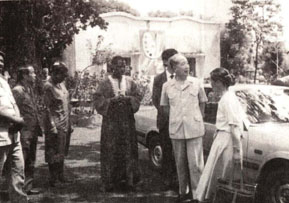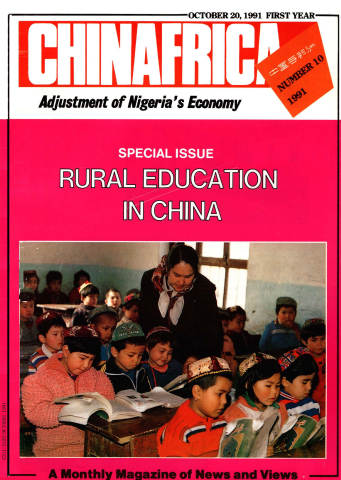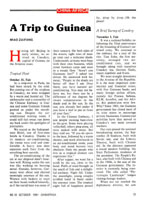Having left Beijing in early winter, we arrived in Conakry, capital of Guinea, on the Atlantic coast.
Tropical Heat
October 31, Fair
At a stop-over in Paris, we had been struck by the cold. But coming out of the airplane in Conakry, we were wrapped by a warm and humid air. The ambassador and a counsellor of the Chinese Embassy in Guinea and some Guinean friends greeted us under the scorching sun. Despite the air-conditioned waiting room, I could still feel sweat run down my back under the spotlights of journalists.
We stayed at the Independence Hotel, one of first-class hotels in Conakry. Thanks to its modern air-conditioning, the rooms were cool and comfortable. A heavy iron door separates each floor from the scorching heat outside.
The air-conditioning of the car at our disposal didn’t function well. Riding under the sun was like walking on burning metal. Outside, however, Guineans went about and chatted seemingly unaware of the sun. Women with baskets or trays on their heads walked leisurely, as if the torrid heat was none of their concern. On both sides of the streets, tight rows of mango trees cast a welcome shade. Underneath, artisans were busy with their own business, while street hawkers came and went in a steady flow. “Aren’t you Guineans hot?” I asked our driver. He answered with humour, “People in the shade are better off than I am. Over there, you have natural air-conditioning. You may not believe me, but there can be a difference of ten degrees between temperatures in the shade and in the sun. In the sun, you already feel cooler if you have a leaf to put in front of your face.”
In the Chinese Embassy, I saw people training bare-chest in the gym. Some were playing volleyball, others ping-pong, all were soaked with sweat. But they told me, “If you do sports in the heat, followed by a warm shower, and work afterwards in an air-conditioned room, your body and mind become very obedient. Only the people who live in a tropical climate can experience this.”
After supper, we went for a stroll by the sea, close to the hotel. Puffs of wind brought us the smell of fish and a delightful coolness. Night fell. Under the moonlight, young couples strolled hand in hand under the coconut trees. The tropical night full of happiness passed by, drop by drop...Oh the peace!
A Brief Survey of Conakry
November 1, Fair
It was a national holiday celebrating the 32nd anniversary of the founding of Guinea’s national army. We returned to the embassy for a tour of the city. Tian Jiahe, the first secretary, arranged two air-conditioned cars, and we brought along with ourselves Conakry tea, thermos flasks, insect repellent and fruits.
We went straight downtown to the Avenue of the Republic. It is the most important commercial and financial street, with five Guinean banks and many foreign airline offices, namely Air France, Sabena, KLM, Aeroflot, and Air Africa. But pedestrians were few. Why? Since 1985, the Guinean government has closed most of its state stores to encourage private businesses. Commercial activities have thus moved to Conakry’s two main covered markets.
Our cars passed the national broadcasting station, the September 28 Stadium, built with Soviet aid, and the Liberty Theatre, built with Chinese aid. In the distance appeared a round modern building: the State Parliament, residence of the president. The People’s Palace, also built with Chinese aid in the 1960s, is the seat of the Guinean government. The interior is currently being renovated. The villa called “Picturesque Landscape” lodges visiting foreign leaders.
When our car reached the diplomatic district, we saw rows of buildings in local style, and the street leading into the district was lined with neatly trimmed bushes and walls covered with ivy and climbing plants in bloom. Next to it are the residential quarters, where corrugated iron roof houses nestle together on the dark ochre laterite, beneath tropical trees. In the streets there were many vehicles, mostly yellow taxis. Due to lack of traffic rules, they often had to make way for passers-by.
The Niger Open Market is one of the two covered markets in Conakry. There, small bazaars and shops are set up in disorder, creating a real labyrinth. Those who do not know the area easily get lost. Loudspeakers spit out music, merchants yell out their products, and vendors and clients hassle over prices in a perpetual world of hubbub and animation. Displays offer all one needs: electric appliances, every day necessities, cereals and edible oils, vegetables, fruits, as well as imported articles. Handicrafts are mostly sold by men who, calculators in hand, profusely vaunt their merchandise. Agricultural products are under the management of women. More hardworking than men, they go about their business while breast-feeding their infants. I badly wanted to take a picture of this animated market, but a Chinese embassy staff advised me not to do so. Because, he said, Guineans do not like to be photographed by foreigners.
Thanks to the embassy’s cars, we entered the port of Conakry without having to go through any formality. It is the biggest foreign trade port in Guinea, with an annual handling capacity of 400,000 tons. Each year, over 270 ships stop here. On the docks, containers piled up high. Eight foreign cargo ships were docked. A Guinean docker told us that two from the Soviet Union with a 58 to 62 percent grade came to load bauxite. Guinea is very rich in bauxite. Its prospected reserves reach 25 billion tons, or two-thirds of the world’s reserves. A “geological miracle,” Guinea is also rich in aluminium, iron reserves amounting to 40 billion tons and a 70 percent grade, diamond reserves reaching 400 million carats, as well as gold, copper, rare metals such as uranium, cobalt, lead and zinc. Because of this, seme say that “Guineans are sitting on a treasure.” This comparison is not exaggerated, one can only regret that these resources have not been fully exploited. But with the right policy, based on economic development, Guinea has a flourishing future in store.
On our way back, we followed the road along the Atlantic Ocean. On one side is the ocean stretching as far as the eye could see. On the other are green foliage and walls covered with red flowers. We returned to the embassy at dusk. Without wasting a minute, I ran to the third floor to admire the sunset. From afar, it looked like a tired sun slowly setting into the Atlantic. Then, all at once, the horizon turned purple. This splendid moment seemed like a dream.
On the Way to Kindia
November 2, Overcast
Today, we visited Kindia, county town of Maritime Guinea, 150 km from Conakry. When I woke up, the sky was grey and I feared it would rain. But Mr. Tian told us the rainy season was over and despite cloudy skies, it would not rain. Hurrah! This climate was ideal for sightseeing. We were to leave at 9:00 in the morning, but our Guinean friends arrived at 9:45. Their car had broken down. To make up for the lost time, we all crammed into the two available cars.
Out of Conakry, a landscape of green fields and harmonious hills unrolled before our eyes. On both sides of the road, ochre coloured paths zigzagged into the fields. People dressed in white, yellow or bright red, formed natural scenes full of life. Each time we crossed a town, we met dense crowds of merchants and buyers around market stalls. Brands of imported products are as striking here as on Conakry's free market. Without a doubt, the liberal measures adopted by the Guinean government have given a new life to rural trade.
We bumped along the mountain road. Fortunately, the variation in the landscape kept us busy. After talking a few minutes with Kindia’s county magistrate, we continued our way. We were now on a small country road: on either sides, dense fields of corn, green beans, cassavas and tomatoes, as well as banana plantations, attested to the region’s fertility. After another half-hour bumpy ride, we arrived at a calm and beautiful site. A 30-metre waterfall rushes down a lush mountain, the sides of which seem to have been cut with a sword. The water cascades gracefully between tender foliage and dark green lianas, at times glistening, at times wreathed in mist. Hence the name the “Bride’s Veil Waterfall.” At the foot of the mountain, the “Bride’s Veil” metamorphoses itself into a fountain of clear water, surrounded by bamboos softly whispering in the breeze. In front are a dozen thatched houses. Each includes two air-conditioned bedrooms and a bathroom, accommodating two families of four. The owner invited us to the open-air bar and served us German beer. According to him, the Guinean government has of late attached much importance to tourism. The “Bride’s Veil” had been part of the national scenic spot, but was later sold to a Guinean professor living in Dakar. The new owner knew the tourist industry and had the houses renovated and staff trained. Recently the site was reopened and many European travellers have already visited.
When we returned to Kindia, it was already two in the afternoon. The county magistrate welcomed us to his house. A courteous young man in his 30s, he was wearing a batik boubou. He talked about his region with much tenderness: the mostly agricultural district of Kindia has a population of 220,000, about 90,000 of them living in the urban area. Here, the vegetation is green all year round. Cereals, vegetables, and fruits are abundant. The underground is rich in bauxite and gold. After the rainy season, farmers do business in town and come back to the countryside for the sowing time. At the open market, we saw fresh agricultural produce in abundance, confirming what the magistrate had told us. For dinner, our host served us a simple but delicious meal of salad, chicken with potatoes, and beef with cassava and rice, finishing off with bananas and oranges. He was not very talkative, but observed us to make sure we did appreciate his meal. It was clear he held the Chinese people and China in esteem.
On the way back to the hotel, every one talked about the magistrate’s hospitality. Thinking about some of the gastronomic excesses in China, we felt ashamed. The good cultural habits of African countries are worth following.
The National Museum
November 3, Fair
It was noon when we finished meeting with five ministers. Full of energy, we decided to visit Guinea’s National Museum. We were greeted in the courtyard by the museum’s director, a middle-aged man. He led us to the shade of a big tree and started talking about his museum.
Located in Conakry, the museum was constructed by white colonialists. The first thatched roof of the museum is still preserved. Today, after successive moves, the museum has an exhibition hall as well as a research centre on historical documents. The exhibition consists essentially of statues presented in the museum’s courtyard and objects showcased inside. The exhibits unroll like a film of Guinea’s history, before and after Western colonization.
The statues in the open air represent figures closely linked to Guinea’s history, namely the Karamotto Dama couple, both Guinean religious leaders. Mr. Dama, along with the famous hero Samoury Tour, led the Guinean people in 1885 in a fight against French invaders. Both fought until Guinea became a colony. They were arrested and exiled in Gabon where their remains are buried. Then there is the statue of the first French governor of Guinea, Mr. Eugene Noel Bally. During his 11 years in power, he undertook the construction of Conakry, built the first railway line and erected the first Guinean hospital. Mr. George Boire, the 7th French governor, introduced in Guinea plough animals, a great step in Guinean agriculture. At this point, I felt much esteem for the Guinean people who respected history. Though the Guineans have suffered from colonialism, they have not undone the constructive achievements of the colonialists.
In the first exhibition hall, a remarkable model clearly depicted the natural geography of Guinea’s four administrative zones. With its 245,000 square km, Guinea is a rich and opulent land. In the west, the coastal plain is suitable for industrial crops; the central plateau is an agricultural, forest and breeding region; the east and northeast are mountainous regions good for breeding; and the southeast is a sea of tropical forests. The buildings, of different styles, showed the multiplicity of Guinea’s ethnics groups: the Soussou, Malinke and Poular have enriched the national civilization with their customs, traditions, religious activities and way of life. Agricultural tools, hunting and fishing gears, costumes and jewelry, tam-tams for long-distance communication, music instruments, ancient coins, sacred and religious objects, all lived again thanks to the explanations of the director. The head of the Chinese delegation commented, “Africa’s old traditions and civilizations, as those of China, are part of the human civilization. The ‘Fertility Goddess,’ like the Chinese Bodhisattva Guanyin, clearly shows the link between the civilizations of all countries.” But as the museum director pointed out, after the independence of Guinea, the government emphasized cultural exchanges with other countries, especially with China, a very ancient oriental country. The two visits in the 1960s of the national ballet troupe “Djoliba” to China are good examples. Upon learning that I had been part of the welcoming party for this troupe back in 1964, in Nanjing, the director was delighted: “Today, this troupe is well known across the world. Currently it is touring Europe. Its acts have become subjects of research for Europeans. A British experts, group is presently studying Djoliba’s acts and is having repetitions done in Guinea.” Hearing this, I remembered a question I always meant to ask, “What is the meaning of Djoliba?” “It is the name of a river,” answered the director. The river is the source of the Senegal and Gambia rivers. After it crosses Mali, it is called the Niger River. This is the origin of the name for the ensemble of Guinean songs and dances, the symbol of longevity and prosperity of African traditional art.
We lingered on in the museum a while longer and parted old friends.

The Chinese delegation visits the National Museum of Guinea. MIAO ZAIFANG

The statue of Karamotto Dama, Guinean religious leader during the Guinean mar against France. MIAO ZAIFANG


 Copy Reference
Copy Reference 